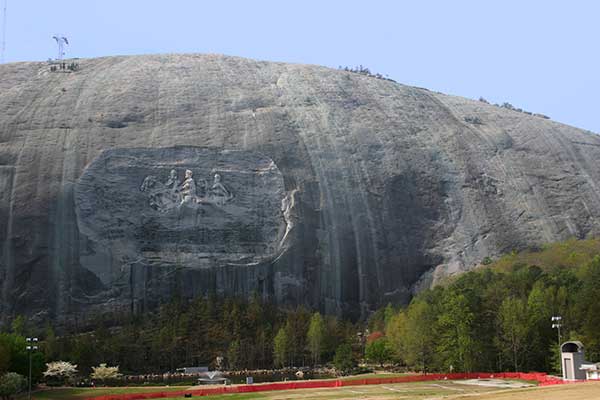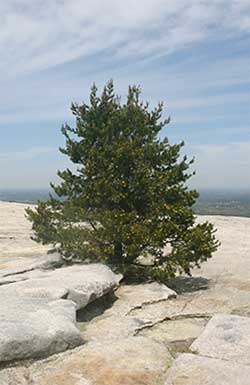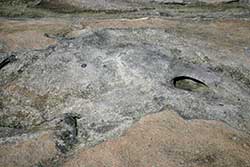I’ve had a guest for the past four days, and it’s been a lot of fun, because it’s given me the opportunity to do something I haven’t done in the three years I’ve lived in Atlanta: play tourist.
So the past several days have been spent running all about Atlanta visiting The Sights. Every town has Sights; in Orlando, The Sights mostly involve an anthropomorphic rodent and his whacky team of intellectual property attorneys, whereas in the tiny farm town of Venango where I grew up, The Sights almost always involved cows. Lots and lots of cows. Cows, and wheat, but mostly cows.
Here in Atlanta, The Sights include Stone Mountain, though I still maintain that perhaps the word “mountain” is a little ambitious.
This is Stone Mountain:

Essentially, it’s a ginormous slab of granite jutting abruptly up out of the ground without any warning, or even any of the things like foothills that proper mountains use to let people know they’re coming.
Quite some time ago, a group of people saw this gigantic piece of granite and said “Hey! We could carve something into that!” Here’s a closeup of the carving that’s been blasted out of the rock:

This being Georgia, we can’t have a carving without invoking the War of Northern Aggression, so the people you see here are none other than General Robert E. Lee, Jefferson Davis, and “Stonewall” Jackson. Lee looks a little long in the face, as he perhaps contemplates the wisdom of an agrarian society going to war with an industrialized society; Davis, heart heavy, ponders what the history books have to say about the fate of such agrarian societies; and Jackson looks stoic as ever, while his horse, arguably the wiser of the two, looks ahead at the future of the Confederacy with wild-eyed terror.
 The current carving is actually blasted out of the remnants of an earlier and much more ambitious carving, designed in 1914 by Gutzon Borglum, a man who would later leave his mark (in a highly literal fashion) on Mt. Rushmore. Borglum was a gifted artist but suffered the unfortunate congenital condition of being a Yankee, so no sooner had he begun than political rivalries erupted which would ultimately culminate in his design being scrapped, and, er, scraped off the granite face by dint of chisels and high explosives. The rest of the history of this monument is caught up in the frightfully ordinary and frightfully dull sort of petty squabbling that tends to accompany confederacies of all sorts, and it wasn’t until 1970 that the second-rate, lackluster monument you see here was finished.
The current carving is actually blasted out of the remnants of an earlier and much more ambitious carving, designed in 1914 by Gutzon Borglum, a man who would later leave his mark (in a highly literal fashion) on Mt. Rushmore. Borglum was a gifted artist but suffered the unfortunate congenital condition of being a Yankee, so no sooner had he begun than political rivalries erupted which would ultimately culminate in his design being scrapped, and, er, scraped off the granite face by dint of chisels and high explosives. The rest of the history of this monument is caught up in the frightfully ordinary and frightfully dull sort of petty squabbling that tends to accompany confederacies of all sorts, and it wasn’t until 1970 that the second-rate, lackluster monument you see here was finished.
The backstory actually makes a more fitting tribute to the Confederate States of America than the stone carving itself, but I digress.
Visitors to Stone Mountain can hike up to the top or, if they are of a more reasonable disposition, take the cable car, which is what we did. The cable car is Swiss-made and offers visitors a few moments of sheer terror to go with the view, something the park employees find endlessly amusing
The top of this lump of rock is actually very cool. This chunk of granite is bigger than God and twice as real, and from the top of it, the view is awe-inspiring.
The wind occasionally blows dust and dirt across the mountain, where it sometimes accumulates in cracks in the rock. This gives rise to a thriving ecosystem, like this tree, which must surely be The Most Optimistic Tree In The World. The dirt in this crevasse extends downward about half an inch or so, so the roots of the tree skitter sideways along the rock like John McCain courting a neocon.
 Granite, unlike silicone, has a regular stress geometry; when it fractures, it tends to fracture in circles. Wind and rain continue with the basic circular theme, so the top of the rock is studded with rounded depressions.
Granite, unlike silicone, has a regular stress geometry; when it fractures, it tends to fracture in circles. Wind and rain continue with the basic circular theme, so the top of the rock is studded with rounded depressions.
These depressions fill with rainwater when it rains, and shortly thereafter the miracle of Life blossoms forth with the promise of renewal, tenacity, and hope in the pit of unrelenting despair we call the Universe. Life, in this case, consists of these rather odd plants that look like grass but are actually quillworts, the rarest of all plant life on Earth.
Quillworts grow in only three places on the planet–all of them unreasonably huge chunks of granite. Perversely, they seem to enjoy sprouting from tiny little depressions in solid rock that fill with rainwater, and becoming dormant again when the water dries up. One would think that they might be a lot more successful if they’d perhaps chosen a less inhospitable ecological niche to occupy, but who am I to judge some other organism’s choices?
The hardiness of these bizarre plants and the fact that they can scrabble out a foothold on such a forbidding surface is a testimonial to the difficult engineering challenge posed by wiping out all life on earth. A lot of folks like to say that nuclear war would wipe out all life on earth; those folks have no idea what a tough job that would actually be.
Oh, it might wipe out all life that we like, which basically means all life that either owes us money or is cute and fuzzy, or all life that we fancy eating, but there’s a great deal of life (much of it slimy, or pinchy, or equipped with stingers, or brown and squidgy and generally unappetizing) that we’d actually be pretty hard-pressed to get rid of. And the weird stuff living in undersea volcanic vents likely wouldn’t take much notice of anything we did, though that’s a post for another day.

This is so awesome, thanks for taking the time to post it. Makes me think about growing up in Niagara Falls’ backyard and taking it for granted all those years. I never thought I’d miss it and used to think people who wanted to get married or honeymoon there were crazy. I get it a lot more now. Plus, thanks to my gf, I have now been on almost every touristy thing there. Woo-hoo! Next trip home I have more historical places to take her. Should be fun.
This is so awesome, thanks for taking the time to post it. Makes me think about growing up in Niagara Falls’ backyard and taking it for granted all those years. I never thought I’d miss it and used to think people who wanted to get married or honeymoon there were crazy. I get it a lot more now. Plus, thanks to my gf, I have now been on almost every touristy thing there. Woo-hoo! Next trip home I have more historical places to take her. Should be fun.
I visited Stone Mountain about 15 years ago, and now, finally, it begins to make a little sense to me. Thank you! I wish there was a place to find this sort of commentary for every example of The Sights.
The problem, I reckon, is that those folks who own the Sights (or at least make money from them) often have a vested interest in a carefully manicured sort of image of the Sights, rather than the more chaotic view favored by your humble scribe.
I visited Stone Mountain about 15 years ago, and now, finally, it begins to make a little sense to me. Thank you! I wish there was a place to find this sort of commentary for every example of The Sights.
…and Jackson looks stoic as ever, while his horse, arguably the wiser of the two, looks ahead at the future of the Confederacy with wild-eyed terror.
I am always so glad I found your journal, every time you throw down something like this.
Seconded – that paragraph is one of the best art interpretations ever. – ZM
Why, thank you! 🙂
…and Jackson looks stoic as ever, while his horse, arguably the wiser of the two, looks ahead at the future of the Confederacy with wild-eyed terror.
I am always so glad I found your journal, every time you throw down something like this.
Man, I’m full of envy… You can really WRITE! Thank you!
Why, thank you! I just calls ’em like I sees ’em.
Man, I’m full of envy… You can really WRITE! Thank you!
It’s just more rock graffiti, and way more harder to remove than spray cans.
It’s just more rock graffiti, and way more harder to remove than spray cans.
Seconded – that paragraph is one of the best art interpretations ever. – ZM
“A lot of folks like to say that nuclear war would wipe out all life on earth; those folks have no idea what a tough job that would actually be.”
Indeed. People like to go around shouting, “Save the planet!” Short of coaxing a moon-sized asteroid to smash into us, human beings simply aren’t magnificent enough to get the job done. The best we can do, as you noted, is to light up as many nuclear devices as we can, in as many places as we can, and hope to God we don’t wake the baby (before its face is seared off). But that’s not the fear the motto hopes to invoke. “Save the planet!” is about cutting emissions, curbing deforestation, saving endangered species, etc. It’s a laudable endeavor, but it’s inaccurate to suggest that failing to do these things will result in the destruction of Earth. Perhaps, as you said, all the things we like will die, but the hulking mass of the planet isn’t going anywhere. Venus is a smoking cauldron of death, a testament to the effects of runaway global warming, yet the planet continues to revolve blithely around its soulless sun. Mars, which might once have hosted life, is now, so far as we can tell, entirely sterile. Yet there it is.
A planet simply has no use for the organisms that skitter across its surface. It is us, the thinking apes, as the title homo sapiens so laughingly implies, that need said organisms. Instead of “Save the planet!” we ought to say, “Destabilize your ecosystem and the planet will go on without you.”
P.S. I heard that the native peoples largely despise the imperialistic representations on Rushmore, which was believed to be a sacred rock.
There have been some organisms in the past which have come pretty close to solving the engineering problems involved in wiping out all life; I’ve actually written before about how the lowly cyanobacteria outclasses our most destructive impulse to date. As it turns out, though, even completely changing the atmosphere of Mother Earth wasn’t enough to do the job.
I can imagine there were some folk who took exception to the carvings on Mt. Rushmore, though after the thing with the smallpox and that other thing with the genocide I reckon the mountain became a relatively minor quibble.
“I can imagine there were some folk who took exception to the carvings on Mt. Rushmore, though after the thing with the smallpox and that other thing with the genocide I reckon the mountain became a relatively minor quibble.”
Too true. I suppose the mountain was more the equivalent of scribbling “Rick was here,” in permanent marker, over some poor sap’s swollen asshole.
“A lot of folks like to say that nuclear war would wipe out all life on earth; those folks have no idea what a tough job that would actually be.”
Indeed. People like to go around shouting, “Save the planet!” Short of coaxing a moon-sized asteroid to smash into us, human beings simply aren’t magnificent enough to get the job done. The best we can do, as you noted, is to light up as many nuclear devices as we can, in as many places as we can, and hope to God we don’t wake the baby (before its face is seared off). But that’s not the fear the motto hopes to invoke. “Save the planet!” is about cutting emissions, curbing deforestation, saving endangered species, etc. It’s a laudable endeavor, but it’s inaccurate to suggest that failing to do these things will result in the destruction of Earth. Perhaps, as you said, all the things we like will die, but the hulking mass of the planet isn’t going anywhere. Venus is a smoking cauldron of death, a testament to the effects of runaway global warming, yet the planet continues to revolve blithely around its soulless sun. Mars, which might once have hosted life, is now, so far as we can tell, entirely sterile. Yet there it is.
A planet simply has no use for the organisms that skitter across its surface. It is us, the thinking apes, as the title homo sapiens so laughingly implies, that need said organisms. Instead of “Save the planet!” we ought to say, “Destabilize your ecosystem and the planet will go on without you.”
P.S. I heard that the native peoples largely despise the imperialistic representations on Rushmore, which was believed to be a sacred rock.
The problem, I reckon, is that those folks who own the Sights (or at least make money from them) often have a vested interest in a carefully manicured sort of image of the Sights, rather than the more chaotic view favored by your humble scribe.
Why, thank you! 🙂
Why, thank you! I just calls ’em like I sees ’em.
There have been some organisms in the past which have come pretty close to solving the engineering problems involved in wiping out all life; I’ve actually written before about how the lowly cyanobacteria outclasses our most destructive impulse to date. As it turns out, though, even completely changing the atmosphere of Mother Earth wasn’t enough to do the job.
I can imagine there were some folk who took exception to the carvings on Mt. Rushmore, though after the thing with the smallpox and that other thing with the genocide I reckon the mountain became a relatively minor quibble.
“I can imagine there were some folk who took exception to the carvings on Mt. Rushmore, though after the thing with the smallpox and that other thing with the genocide I reckon the mountain became a relatively minor quibble.”
Too true. I suppose the mountain was more the equivalent of scribbling “Rick was here,” in permanent marker, over some poor sap’s swollen asshole.
why, exactly, is there NOT a condom named the Transform Ultra, and what are you going to do to rectify that situation?
why, exactly, is there NOT a condom named the Transform Ultra, and what are you going to do to rectify that situation?